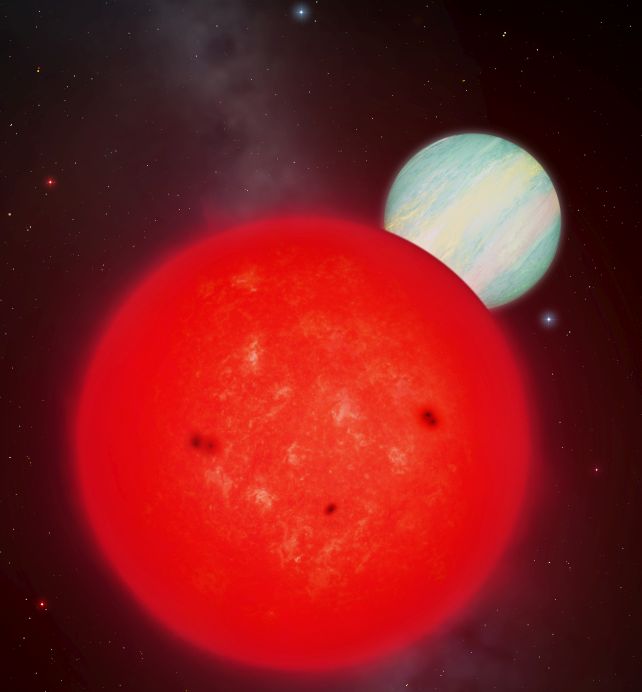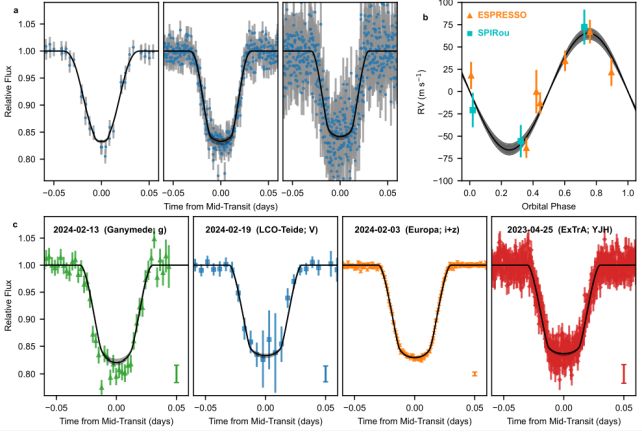A giant conundrum has been found orbiting a teeny tiny red dwarf star just a fifth of the size of the Sun.
Such small stars were thought to be incapable of producing giant planets. But there, in its orbit, appears to be unmistakable evidence of an absolute unit: a gas giant around the size of Saturn.
TOI-6894b, as the exoplanet is named, has 86 percent of the radius of Jupiter. At just 23 percent of the radius and 21 percent of the mass of the Sun, its parent TOI-6894 is the smallest star yet around which a giant world has been found.
"I was very excited by this discovery," says astrophysicist Edward Bryant of the University of Warwick in the UK, who led the large international research team.
"We did not expect planets like TOI-6894b to be able to form around stars this low-mass. This discovery will be a cornerstone for understanding the extremes of giant planet formation."

Planets are born from the material that's left over from the formation processes of its host star. Stars form when a dense clump of material in a cloud of gas and dust collapses under gravity. Material from that cloud spools around the spinning protostar in a disk that feeds the star's growth; when the star is large enough to push the material away with its stellar wind, growth stops.
The remaining material is what makes planets. The dust clumps together, gradually building worlds that end up orbiting the star.
Here's the thing, though. The amount of material in the disk is thought to be proportional to the mass of the star. The reason tiny red dwarf stars shouldn't be able to make giant planets is because there just oughtn't be enough material to do so.
Nevertheless, these strange, 'impossible' systems show up from time to time, suggesting not just that giant planets can form around tiny stars, but that the process is not all that uncommon. We don't have a good handle on just how common it is, so Bryant and his team embarked on a mission to scour TESS data for clues.
"I originally searched through TESS observations of more than 91,000 low-mass red-dwarf stars looking for giant planets," he says. "Then, using observations taken with one of the world's largest telescopes, ESO's VLT, I discovered TOI-6894b, a giant planet transiting the lowest mass star known to date to host such a planet."
Exoplanets are usually found via a technique known as the transit method. When an exoplanet orbiting a star passes between us, the observers, and the star, that star's light dims minutely. Astronomers can determine the presence of an exoplanet by looking for periodic dips in the star's light. It's usually a tiny signal that takes quite a bit of analysis to find.

When the researchers looked at TOI-6894, they found its light dimming by an absolutely whopping 17 percent. According to the team's observations of the transits, that would make the diameter of the star about 320,000 kilometers (200,000 miles), while the exoplanet is around 120,000 kilometers across.
Follow-up observations to see how much this giant exoplanet's gravity affects the orbital motion of the star revealed the mass of TOI-6894b. It's just 17 percent of the mass of Jupiter, suggesting an exoplanet atmosphere that is light and fluffy.
This is exciting for a few reasons. Because the exoplanet has such deep transits, it's a perfect candidate for atmosphere study. During those transits, some of the star's light filters through the diffuse atmosphere. As it does so, it can become altered by the atoms and molecules therein, allowing scientists to literally see what TOI-6894b is made of.
A team of astronomers has already applied for time with JWST to perform these atmospheric studies. Because the exoplanet is quite cool (temperature wise, but also just in general), they expect to find a lot of methane.

"This system provides a new challenge for models of planet formation, and it offers a very interesting target for follow-up observations to characterize its atmosphere," says astrophysicist Andrés Jordán of the Millennium Institute of Astrophysics in Chile.
Hopefully, these studies will also shed some light on how TOI-6894b formed. There are two scenarios astronomers prefer for gas giants: a gradual accumulation of material from the bottom up, or the direct collapse of an instability in the protoplanetary disk.
Based on the team's observations, neither scenario quite works. More detail on the composition of TOI-6894b could help tease out which is the more likely pathway for the formation of giant worlds orbiting tiny stars.
"It's an intriguing discovery. We don't really understand how a star with so little mass can form such a massive planet!" says astrophysicist Vincent Van Eylen of University College London.
"This is one of the goals of the search for more exoplanets. By finding planetary systems different from our Solar System, we can test our models and better understand how our own Solar System formed."
The discovery has been published in Nature Astronomy.
